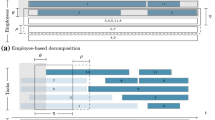Summary
Assignment of personnel is a task involving a multiplicity of simultaneous goals. It is demonstrated that multiobjective programming in a combinatoric medium is feasible both methodologically and computationally. FollowingGeoffrion, it is assumed that the decision-maker has in mind an implicit function mapping the numerical values of the objectives to the real line. The proposed strategy consists in the decision-maker choosing first- and second-best assignments from a given set, in each stage of a decision-tree-like-procedure. The computation is reducible to well-known problems of assignment and shortest routes, for which efficient solution techniques exist.
Zusammenfassung
Beim Problem der Personalzuordnung sind i.a. mehrere Ziele gleichzeitig zu berücksichtigen. Es wird gezeigt, daß die Lösung des entsprechenden kombinatorischen Problems mit mehreren Zielfunktionen sowohl von der Methode als auch vom Rechenaufwand her möglich ist. GemäßGeoffrion wird angenommen, daß der Entscheidungsträger eine implizite Funktion berücksichtigt, die die numerischen Werte der Ziele auf reale Zahlengeraden abbildet. Die vorgeschlagene Strategie besteht darin, daß der Entscheidungsträger aus einer vorgegebenen Menge beste und zweitbeste Zuordnungen auswählt. Das Vorgehen entspricht dabei der Arbeitsweise an einem Entscheidungsbaum, wobei diese Auswahl auf jede Stufe getroffen wird. Die Berechnung läßt sich auf die Lösung von bekannten Zuordnungs- und Kürzeste-Weg-Probleme zurückführen, für die effiziente Lösungsverfahren existieren.
Similar content being viewed by others
References
Brucker, P.: All Shortest Distances in Networks with Large Number of Strong Components, 41st National Meeting of ORSA, New Orleans, 1972.
Dantzig, G. B.: Linear Programming and Extensions, Princeton, N. J., 1963.
Dreyfus, S. E.: An Appraisal of Some Shortest Path Algorithms, Oper. Res.17, 395–412, 1969.
Ewashko, T.A., andR. C. Dudding: Application of Kuhn's Hungarian Assignment Algorithm to Posting Servicemen, Oper. Res.19, 991, 1971.
Floyd, R. W.: Algorithm 97: Shortest Path, Communication of ACM6, 345-, 1962.
Geoffrion, A. M.: Vector Maximal Decomposition Programming, 7th Mathematical Programming Symposium, The Hague, September 1970.
Hillier, F. S., andG. J. Lieberman: Introduction to Operations Research, pp. 172–204, San Francisco, 1967.
Little, J. C. C. et al.: An Algorithm for the Traveling Salesman Problem, Oper. Res.11, 972–989, 1963.
Machol, R. E.: An Application of the Assignment Problem, Oper. Res.18, 745–746, 1970.
Ore, O.: Theory of Graphs, American Mathematical Society, Providence, R. I., 1962.
Roy, B.: Problems and Methods with Multiple Objective Functions, Mathematical Programming1, 239–266, 1971.
Author information
Authors and Affiliations
Additional information
Project supported in part by the Office of Naval Research under Contract N-00014-67-A-0012-0011; U.S. Atomic Energy Commission Contract AT(04-3)-326-PA 18; and National Science Foundation, Grant GP 31393.
Rights and permissions
About this article
Cite this article
Pollatscheck, M.A. Personnel assignment by multiobjective programming. Zeitschrift für Operations Research 20, 161–170 (1976). https://doi.org/10.1007/BF01920261
Received:
Revised:
Issue Date:
DOI: https://doi.org/10.1007/BF01920261




